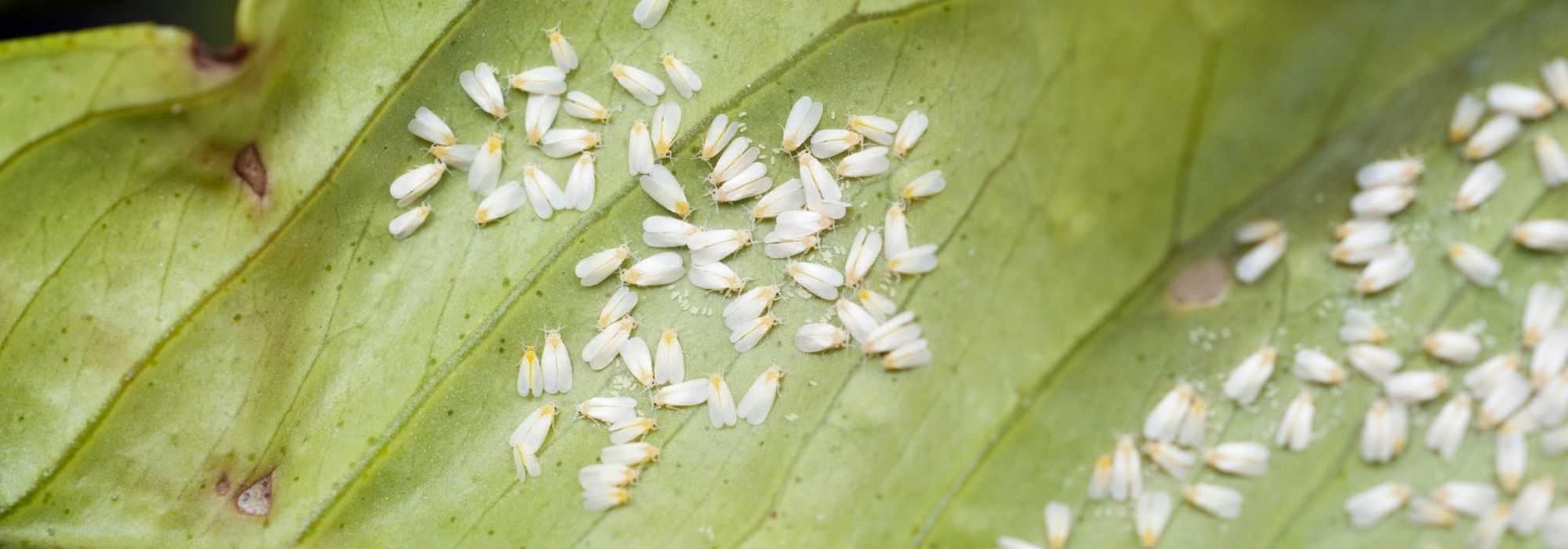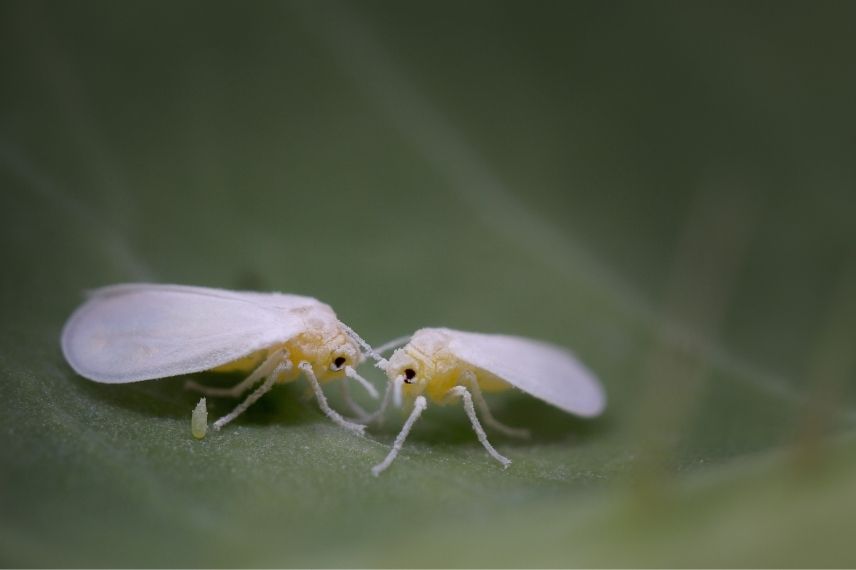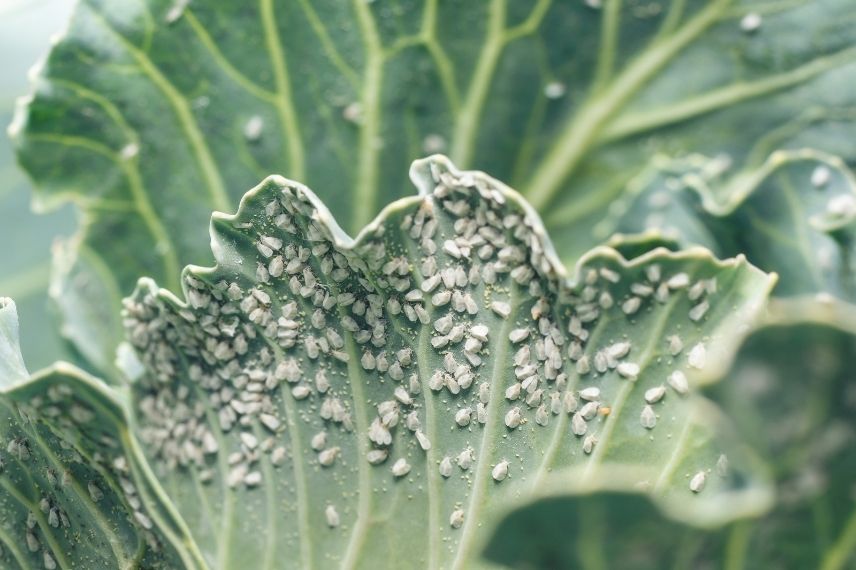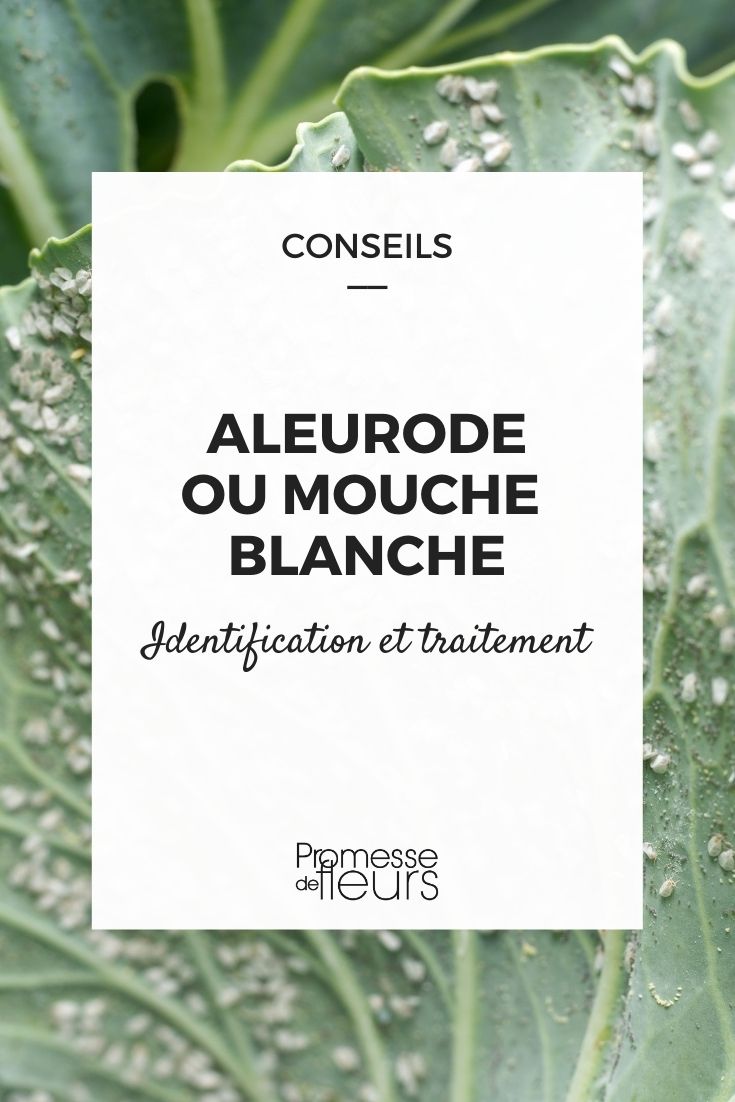
Whitefly or aleurode: identification and treatment
A particularly problematic pest...
Contents
Under glass, in the garden or even indoors, one of the most common and most dangerous pests of plants is the whitefly. It is easy to recognise: as soon as you approach a plant, a real white cloud rises and only settles a few seconds later. These whiteflies are insects that reproduce at an astonishing rate and attack a wide range of plants. Whiteflies feed on plant sap, which weakens the plant and can, in some cases, cause its death. Fortunately, natural solutions exist. But what exactly is this curious little white insect and how can you protect plants from it? We explain everything in this advice sheet.
Aleurode or whitefly: what is this insect?
Aleurodes, also called whiteflies, are insects forming a superfamily in their own right: the Aleurodidae. The aleurodids themselves belong to the suborder Sternorrhyncha (scale insects, psyllids and aphids…). There are 1,200 species of aleurodes worldwide but only 56 in Europe. Most of these insects were accidentally imported from South and Central America (but others come from Asia). This is why they prefer heat.
They are found everywhere: indoors, in conservatories, in greenhouses or cold frames but also in gardens or in crops.
Adults measure barely 3 mm long at most (depending on species) and have two pairs of wings covered with a white powder. This floury dust also covers the insect’s body. They are insects equipped with piercing-sucking mouthparts. Aleurodes suck sap from plants which weakens them, even kills them.
Whiteflies are easily recognised because they form real white clouds when disturbed. Adults flutter about 40 cm above their host plant before landing again a few seconds later. Presence of eggs and very small immobile larvae (2 mm long) on underside of leaves is also characteristic.
Among many species, the best known are :
- Greenhouse whitefly (Trialeurodes vaporariorum) : in greenhouses and attacks, among others, tomatoes, aubergines, cucumbers or poinsettias;
- Tobacco whitefly (Bemisia tabaci) : in greenhouses and feeds on a large number of plants, notably vegetables;
- Cabbage whitefly (Aleyrodes proletella) : in greenhouses and outdoors and attacks vegetables in vegetable gardens;
- Strawberry whitefly (Aleyrodes lonicerae) : in greenhouses and outdoors and mainly attacks strawberry plants.

Close-up of whiteflies and an egg
Whitefly life cycle
Whiteflies like heat. These insects are therefore present indoors from April to May, in greenhouses and in cold frames but only outdoors from June–July.
The development of these insects is heterometabolous: progressive but incomplete metamorphosis without a true nymphal stage between larva and adult (completely different from butterflies, for example).
Eggs are very small, barely 0.2 mm long, and attached to leaves by a short pedicel. These and the larvae are fixed to the underside of leaves and covered with a waxy coating. Incubation takes 6 to 20 days depending on temperature.
Once hatched from the egg, the larva will pass through four larval stages. The first stage is called “crawler” because it is mobile. The following stages are sessile, meaning the larva is fixed to the leaf and therefore immobile. The fourth and final stage is called “puparium” or pseudonymph. The entire larval transformation takes between 18 and 70 days.
Adults live only between 20 and 30 days but a female can lay up to 600 eggs. Outdoors, whiteflies can produce four or five overlapping generations per year; in greenhouses or indoors, up to 10 generations are possible.
These whiteflies can cause serious damage
Whiteflies are fairly polyphagous. These insects feed on sap of a large number of different plant species. They can attack:
- Solanaceae : potato but especially tomato, pepper, aubergine…
- Cucurbitaceae : pumpkin, squash, courgette…
- Beans
- Cabbages
- Strawberry plants
- citrus trees
- Certain aromatic plants: mint, lemon balm, verbena, marjoram…
- Ornamentals: azalea and rhododendron, fuchsia, hibiscus, pelargonium, celandine…
- Houseplants
Consequences of a whitefly infestation can be devastating for plant or entire crop. Firstly, whiteflies, larvae and adults, will suck sap from plant. This sap removal will weaken plant, sometimes to death if no action is taken.
Secondly, whiteflies, like aphids, excrete honeydew through an opening. This honeydew accumulates beneath leaves and constitutes a “substrate” suitable for development of a pathogenous fungus: sooty mould. This disease appears as a sort of blackish coating under leaves. Honeydew can also provide food for many pathogenous bacteria.
Finally, it should not be forgotten that whiteflies, through punctures they inflict on leaves, can create entry points for phytoviruses and are also vectors by transmitting viruses from one plant to another. Main genera of these phytoviruses are Crinivirus, Carlavirus, Ipomovirus and Begomovirus.

Colony of whiteflies on cabbage leaves
How to deal with whitefly infestation?
Faced with whiteflies, it is important to act early, at first signs of presence and, if possible, isolate infested plant. This is obviously tricky in garden…
Natural predators
Like any insect, whiteflies have natural predators.
- Encarsia formosa and Eretmocerus eremicus are both micro‑wasps that lay eggs on larvae (ectoparasite). Wasp larva emerges from egg then feasts on whitefly larvae. Each micro‑wasp can lay about 150 eggs;
- Macrolophus pygmaeus (formerly M. caliginosus) is a small green bug (Miridae) that feeds on whitefly larvae and adults. This beneficial insect is available from our online nursery.
- Delphastus pusillus is a small all‑black ladybird that feeds on eggs and larvae of whiteflies;
- Dicyphus hesperus is a bug (Miridae) specialised in controlling thrips and whiteflies. It is not host‑specific and hunts a wide range of pest insects.
Trapping adults
If whitefly attack is still in early stages, use yellow cardboard strips coated with glue or honey or, failing that, yellow sticky tape. These devices, hung in greenhouse or directly on plants, are only effective at start of infestation. Warning! Yellow does not attract only whiteflies but many insects. You therefore risk unintentionally killing useful insects (predators, pollinators…).
Natural treatments
- Soapy water: soapy water (black soap) mixed with a few drops of vegetable oil is a good insecticidal solution to apply by spraying. Black soap helps dislodge larvae and eggs while oil suffocates them.
- Rose geranium essential oil (Pelargonium X asperum): this essential oil is insecticidal and effective against whiteflies. Twenty drops of this essential oil diluted in one litre of water is sufficient for spraying under leaves;
- Oil paint: if there are few whitefly larvae on plant, you can try brushing under leaves with a brush dipped in vegetable oil to remove them.
Effective repellents
- Nettle manure: in addition to strengthening plant defenses, nettle manure is effective as repellent against whiteflies;
- Tagetes, basil and Arnica: these three plants emit an odour that repels whiteflies. But plant them before heavy attack occurs.
Good to know
Whiteflies dislike cool temperatures (10°C) and humidity. To prevent possible attack by these insects, move indoor plants outside or open wide cold frames and greenhouse vents when weather is cool and it is raining. However, beware of thermal shock for plants.
Did you know?
- Name “aleurode” derives from a Greek word meaning “wheat flour” in reference to white powder covering wings and body of whiteflies;
- Aleurodes were once classified in order Lepidoptera, that is butterflies, by Carl von Linné;
- A 2019 study demonstrated aleurodes were able to “hack” defence system of attacked plants. Plants then send chemical signals that weaken microorganisms meant to attack aleurodes. Whiteflies then have free rein to suck plant sap;
- Aleurodes resist many chemical insecticidal products because eggs and larvae are protected by a layer of wax. Only adults are then affected. Only systemic insecticidal products, that is those carried by sap, are effective in cultivation.
- Subscribe!
- Contents
































Comments